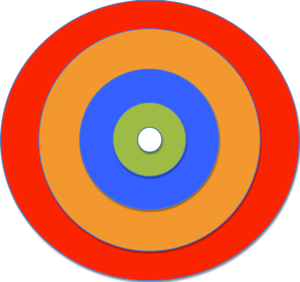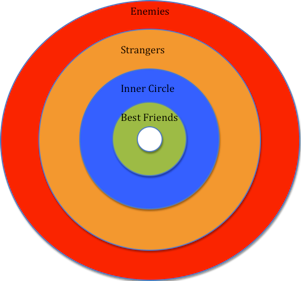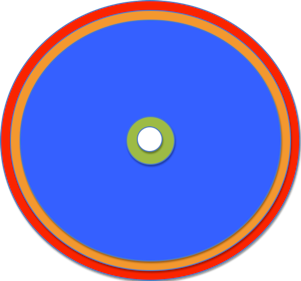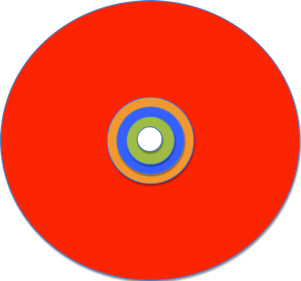Zebra Guru



Some of the most common questions I am asked are in regards to zebra temperament and personality. How are they different than a horse? Are they mean? Zebras differ from horses in 5 key ways:
1. Zebras are wild animals, their wild instincts are much closer to the surface than horses.
2. Zebras are stronger than a horse of similar size
3. The reaction times of zebras are MUCH faster than that of a horse
4. Zebras learn very fast and remember what they learn much better than a horse. This goes for good things and bad habits too.
5. They have a slightly different social structure than a horse.
Although I tend to stay away from generalizations, most zebras do exhibit similar behavior traits. To understand the individual social relationships of a zebra (not the behavior as a herd, but rather how an individual zebra views the world), it’s easiest to start with picturing a bull’s-eye, with the zebra in the center, like this:
Now, imagine that each ring represents a different level of trust, according to the zebra.
The WHITE circle is the zebra.
The GREEN circle represents the “best friend(s).” This can be a person or an animal and its membership is normally reserved for a small group. Usually there is only one of these, but sometimes there are 2 or 3. Anyone within this group has the zebra’s complete trust and often forms a life-long bond with it.
The BLUE circle represents the zebra’s “inner circle” of acquaintances. These are people or animals that the zebra is familiar with, trusts, and is openly friendly towards. The level of trust the zebra extends to members of this circle is not the same as the level of trust enjoyed by the best friends. There are generally more people or animals in this circle than occupy the best friends level.
The Orange circle represents “strangers.” These are often people or animals that the zebra is unsure about. They are often treated with aloof behavior, sometimes ignored, or watched cautiously from a distance. With many zebras, most people that it is unfamiliar with will fall into this circle.
The RED circle represents “enemies.” These are people or animals that the zebra has determined to be a threat in one way or another. The zebra may be threatened physically (fears harm to itself or its herd), or it may be threatened mentally (fears a loss of territory, herd mates, dominance or easy living...aka free meals and no work!). People or animals in the red circle will be met with open aggression and dominant behavior. If possible and necessary, the zebra will resort to physically crowding, biting, kicking or striking with a foreleg at enemies.
Your circle now looks like this:


With a basic understanding of zebra social behavior and relationships, its possible to move a little deeper and examine how that model fluctuates. The model for zebra social relationships is not a one-size-fits-all. It is dynamic and changes not just from one zebra to the next, but changes in environment and stress level may cause the social relationship structure to shift for an individual zebra. It is possible to change how this model looks with behavior modification, environmental changes and training.
For example, Zack is a zebra who is highly social. I am probably his favorite person, therefore his “best friend,” but nearly everyone he comes in contact with is immediately placed within his “inner circle.” He meets most people with affection and trust. This tendency has become more pronounced as his level of training has increased. His circle would look more like this:
In contrast, a zebra with severe behavior problems would have a very different circle. There are many causes of aggression in zebras including lack of respect, lack of social interaction, poor treatment (abuse), high stress environments, lack of stability in their life and too much pressure placed on them in training. Not all aggression is caused by the handler, sometimes animals, just like people, have their own inborn personalities that are simply not friendly or social. Some zebras have physical problems that can cause aggression such as hormone imbalances, chemical imbalances, sexual frustration or any number of other physical or metabolic abnormalities that can cause behavior problems in humans too. A zebra with these kinds of problems might have a social circle that looks more like this:
Knowing that a zebra’s social circle is dynamic and can change begs the question of how do we change it? Change is accomplished through behavior modification, training, environmental adjustments and nutrition. This recipe has succeeded in effecting change in the behavior of many troubled zebras. But, it is far better to use this to help young zebras to grow up balanced, happy and safe. It is always easier to prevent a problem than to fix it when it becomes established. It is our duty to ensure that any animal under our care has the best life possible; that means planning for the future. As an owner or handler it is important to make sure that we are not building a problem that will end up in a terrible situation or injury to the zebra, people or the animals around the zebra.
One of the primary goals of the Zebra Guru Clinics is to help people learn how to handle and train their zebras successfully and how to better understand their interactions with their zebras (from the zebra’s point of view). Hand-in-hand with that is discussing how to change bad behaviors into good ones.


